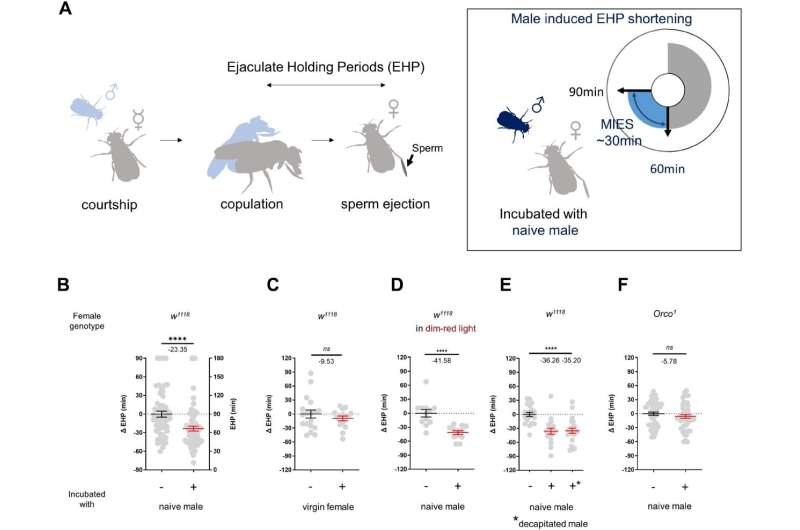This article has been reviewed according to Science X's editorial process and policies. Editors have highlighted the following attributes while ensuring the content's credibility:
fact-checked
peer-reviewed publication
trusted source
proofread
Study provides evidence for sexual plasticity in female fruit flies

Female fruit flies use male pheromones to assess their social context and shorten the amount of time they store sperm after mating, allowing them to re-mate sooner, according to a new study.
The research, published in eLife as a reviewed preprint, provides convincing evidence that the ejaculate holding period (EHP) in female fruit flies is significantly shortened when exposed to the male pheromones, 2-methyltetracosane and 7-Tricosene. These findings pave the way to understanding more about the neural processes behind sexual plasticity.
Sexual plasticity—the ability to modify sexual state or reproductive behavior in response to changing social conditions—is observed in both vertebrate and invertebrate species. In birds and insects, females uptake sperm for a specific duration after copulation, the EHP, before expelling it and reengaging in mating.
"Sperm ejection is a process through which females of various species can remove the male ejaculate or the mating plug after copulation," says lead author Minsik Yun, a postdoctoral researcher in the School of Life Sciences, Gwangju Institute of Science and Technology, Gwangju, Republic of Korea.
"In the fruit fly Drosophila melanogaster, this typically occurs 90 minutes after mating. To this point, whether the EHP and sperm ejection are influenced by the females' social surroundings remains to be confirmed."
To investigate this further, Yun and colleagues first conducted a comparison between the EHP of post-mating female fruit flies isolated from any male presence to those exposed to actively courting males immediately following copulation. They found that the EHP of the group exposed to courting males was roughly 30 minutes shorter than those left in isolation—a phenomenon the team dubs "male-induced EHP shortening" (MIES).
Next, the team looked to uncover the mechanisms behind MIES. After establishing that MIES did not rely on visual or auditory cues, they knew that it must be brought about via olfactory or gustatory cues instead. In fruit flies, the olfactory system detects airborne chemicals through sensory neurons, specifically olfactory receptor neurons (ORN), in their antennae, guiding their foraging and mating behaviors. The gustatory system, located on their mouthparts and legs, is typically associated with discerning the quality of potential food sources and also assessing the quality of their potential mating partners.
To explore the contribution of ORNs to MIES, the team silenced 11 different groups of ORNs by expressing either the active or inactive form of the Tetanus toxin light chain. They found that several of these groups influenced MIES, but they focused specifically on Or47b-positive ORNs, as these, unlike the others, resulted in a near complete abolition of MIES when silenced.
To identify the specific male pheromone that acted on these ORNs, they incubated female flies once again, but with closely related species that have different profiles of pheromones. By comparing and contrasting the pheromones of the species that induced MIES in the females with those that did not, the team could identify the responsible pheromone: 2-methyltetracosane (2MC), which acts upon the Or47b receptor to shorten the EHP in female fruit flies.
The team also found that the gustatory system was involved in bringing about MIES. Through their experiments, they noticed that, when recently mated female flies were incubated with other recently mated females, their EHP was significantly shortened.
Mated female flies carry male pheromones, including 7-Tricosene (7-T) and cVA, which are transferred during copulation. So, the team incubated recently mated female flies with a piece of paper infused with both pheromones. cVa had no effect on the EHP, but 7-T significantly shortened the EHP by acting through ppk23 neurons. This implies that food odors, might also influence EHP, although this requires further study.
Based on previous research, the team knew that the timing of sperm ejection is determined by a neuropeptide called Dh44, secreted by Dh44-PI neurons within the female fruit fly brain. From their own work, they also knew that pC1 neurons express Dh44 receptors and show the elevated activity of cAMP (a molecule that plays a crucial role in cellular signaling pathways, mediating responses to various stimuli such as hormones and sensory signals) during sexual maturation.
To assess whether these pC1 neurons play a role in MIES, they prepared female flies that selectively produce the CRE-Luciferase reporter gene in pC1b and pC1c neurons. When exposed to 2MC or 7-T, these neurons showed a significant increase in CRE-Luciferase activity, indicating a higher level of cAMP production in response to the pheromones. This in turn increased the excitability of the pC1 neurons and subsequently shortened the EHP, promoting sperm ejection.
The authors call for further study to expand upon their findings. Namely, it has previously been shown that physiological factors such as the nutritional status of females or their male partners before mating can impact the EHP. Whether this can also impact MIES remains to be determined, and it is unclear how additional central neurons, such as Dh44-PI neurons, interact with pC1 neurons to modulate EHP and MIES.
"Our study demonstrates that two male pheromones, 2MC and 7-T, significantly shorten the EHP of female fruit flies through Or47b and ppk23 neurons, respectively," concludes senior author Young-Joon Kim, Professor of Life Sciences at the Gwangju Institute of Science and Technology.
"These pheromonal pathways converge onto pC1 neurons, increasing both their cAMP levels and excitability, rendering them more responsive to male courtship cues and promoting further mating after the removal of the mating plug."
"Our findings establish a behavioral model for sexual plasticity and provide a framework for understanding the involved neural processes," adds Yun.
More information: Minsik Yun et al, Male cuticular pheromones stimulate removal of the mating plug and promote re-mating through pC1 neurons in Drosophila females, eLife (2024). DOI: 10.7554/eLife.96013.1
Journal information: eLife
Provided by eLife




















